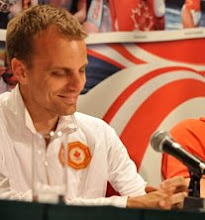As I mentioned in my introduction post, I have closely followed CIS (Canadian university) football for some time. Although I do not intend to provide much comment on that sport here, I thought it would be appropriate to give mention this week, heading into the two national semi-final games. Besides, I could argue, outside of curling, CIS football could be the most watched amateur sport in the country (there will be more than 20,000 people at the two games this weekend and they will likely be watched by about 150,000 people on television.
The Uteck Bowl, played annually in the eastern most location of a Bowl game, pits the Laval Rouge et Or against the Acadia Axemen in Ste. Foy, Que.. Laval is the heavy favourite, having defeated Acadian 34-7 earlier in the year. Additionally, the Atlantic league went 1-7 in inter-league competition against the Quebec loop this season.
For those unfamiliar with CIS football, Laval operates off of a unique private-public partnership model. What that means is that the institution does not cover the operating costs of the football program. Instead, the football team is run by a private investor. As a result, Laval is able to spend a great deal more than most other programs in the country. It’s been successful. Laval captured the national championship in 1999, 2003 and 2004 It’s successful off-the-field as well, attracting about 18,000 fans per game.
It’s success has spurred three other football programs ( University of Regina Rams, University de Montreal Carabins and University de Sherbrooke Vert et Or ) and a hockey program ( Lakehead University Thunderwolves) that operate off of a simular model.
It isn’t without controversy. There are many people who feel that programs in the hands of private investors are more likely to circumvent CIS rules, particularly as they relate to academic requirements. However, there are others who point out that the model allows schools who otherwise wouldn’t be able to afford certain sports the opportunity to participate in those sports. It also, supporters say, generates revenue, which can be used to help smaller profile sports at the institution.
It’s an intriguing debate with wide-reaching ramifications.
The other match-up, the Mitchell Bowl, takes place in Ottawa and features the University of Ottawa against the University of Saskatchewan.
Throughout the last decade, Saskatchewan has consistently been a contender for the national championship. The Huskies play host to the Vanier Cup this year in Saskatoon, so the pressure is on to ensure that their is a home team in the big game.
The biggest question with Ottawa has to do with the league it plays in. Prior to last year’s win by Wilfrid Laurier, it had been 11 years since an OUA team had captured the Vanier Cup. Actually, Ontario is 3-10 in its last 13 playoff games against out-of-province competition. The likely reason for the poor record is that Ontario has traditionally offered less scholarship money to its athletes and has recruited fewer players with junior football experience (who are therefore older).
There is a school of thought that suggests that WLU’s win in ‘05 was a one-off thing and that Ontario is still far behind the rest of the country. Many people are unwilling to consider Ottawa on the same level as the nation’s other top ranked programs until they beat a team from outside the province.
Both games go Saturday. For more information than you will ever need go here


No comments:
Post a Comment